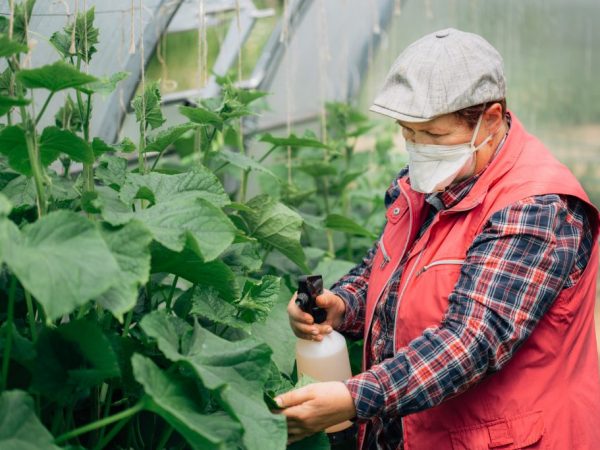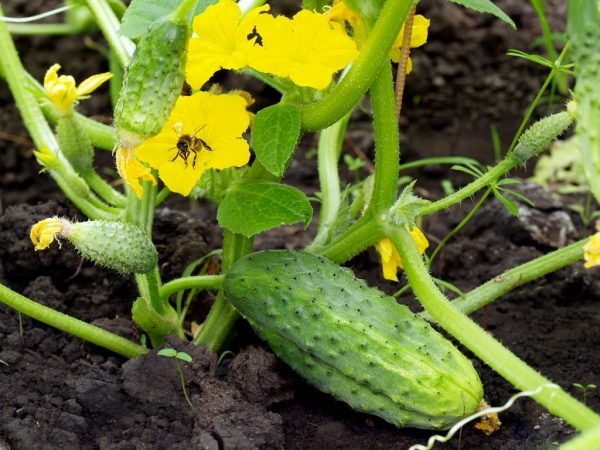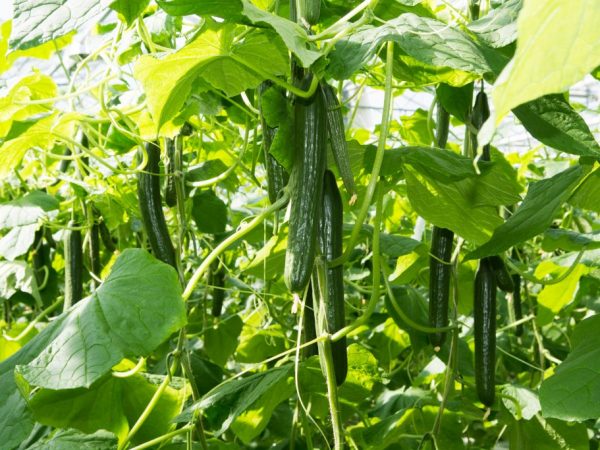How to feed cucumbers in a greenhouse
Getting a bountiful harvest is a merit of the attentive farmer. When growing vegetables in greenhouses, it is necessary not only to ensure the correct temperature and humidity, but also to add the substances necessary for the development in time. How to feed cucumbers in a greenhouse? Let's take a closer look at the intricacies of an important procedure.

Fertilizing cucumbers in the greenhouse
Where to begin
A rich harvest is not only a high-quality seed material, but also an attentive attitude of the farmer to the plants. The conditions for the formation of healthy seedlings always depend on the nutritional value of the soil on which the vegetable vine develops. The crop reacts painfully to micronutrient deficiencies, so it is important to properly prepare the greenhouse before planting seeds.
After the previous fruits are harvested, the greenhouse is carefully cleaned. They remove plant residues, dig up and disinfect the soil. For the winter, compost or rotted manure is added to the soil. Dolomite flour or fluff lime is added to reduce acidity.
In early spring, the loosening procedure is repeated. An important event is held at least 2 weeks before the start of planting work.
Fertilizer
As a fertilizer for cucumbers in a greenhouse, a mixture is used, which includes (in grams):
- potassium salt - 20;
- superphosphate - 25;
- potassium sulfate - 15;
- ammonium nitrate - 30.
After the soil has been fed and dug up, the soil is watered with a warm solution of potassium permanganate and covered with dense polyethylene. This trick allows not only to provide plants with all the nutrients, but also to protect against infections. The film is removed just before planting.
Feeding schedule
When to fertilize cucumbers in the greenhouse? Despite the fact that the vegetable liana belongs to the gluttonous species, there is a set of rules for normal development. For each stage of formation, certain mineral supplements are required.
- The beginning of the growing season. After the seeds have sprouted and 3 adult leaves have appeared, the first application can be carried out. A strong root system intensively assimilates nitrogen, which activates metabolic processes.
- The development of the lashes. During this period, the plant needs potassium, which is responsible for the formation of shoots.
- Bloom. To ensure the normal process of budding and fruit setting, the culture needs phosphorus.
Top dressing in a polycarbonate greenhouse
Fertilizing cucumbers in a polycarbonate greenhouse has some differences from the basic requirements. The fact is that in a closed ground, the culture does not receive enough sunlight, so it needs additional support in the form of minerals.
In order for the seedlings to grow healthy, fertilization is carried out in several stages:
- 2 weeks after sowing;
- before flowering;
- after the petals fall;
- during the formation of fruits.
On average, the application takes place every 10-15 days.The most difficult period for a vegetable liana is during the ripening of cucumbers. For better assimilation of substances, farmers recommend to spray the culture with adaptive preparations "Epin" or "Zircon".
How to fertilize

You need to choose the right method of fertilizing
To provide a full-fledged menu, not only root irrigation is carried out, but also irrigation with fertilizer solutions on the leaf. What is the difference between the types of application and when is this or that procedure needed? In order not to get confused, it is necessary to understand in detail agricultural activities.
- The first feeding of cucumbers in the greenhouse is always carried out at the root. During this period, the underground parts are already sufficiently developed, therefore they easily absorb the proposed mixtures. It is important not to try to feed the plants earlier than 2 weeks after germination, otherwise the chemicals will burn the delicate tissues.
- Foliar procedures in a greenhouse are best done in cloudy weather. With a lack of sunlight, nutrients are poorly absorbed. Sheet processing quickly delivers the required components, activating metabolic processes. Experienced gardeners recommend alternating agricultural work.
- Fertilization by irrigation takes place after irrigation. Pouring a chemical or organic solution onto untreated roots may result in burns. After such procedures, the plants recover for a long time, which worsens the yield.
- Foliar dressing of cucumbers in the greenhouse is carried out with any complex preparation. The product is dissolved in water according to the instructions, filtered and poured into a special sprayer. To protect yourself from chemical poisoning, you must cover your face and body with protective clothing.
Complex mixtures
How to feed cucumbers in a greenhouse? A complete diet for a vegetable vine can be obtained by mixing ready-made minerals. Inexpensive industrial options are easy to buy at any hardware store.
Ammofoska
A universal fertilizer containing elements important for plant development. This is a great option for spring and summer feeding, but it is contraindicated in autumn (it enhances foliage growth). Suitable for all types of soil, especially relevant for regions with arid climates.
The drug begins to act as soon as it enters the soil. Due to its optimal composition, it activates the metabolic processes of culture at all stages of development. It does not require any other additives, therefore it is often used as a sole complex.
Nitrophoska
A more concentrated version of ammophoska, which is produced in the form of granules. As a top dressing for cucumbers in a greenhouse, a sulfuric acid modification is suitable. The product not only fertilizes plants, but also repels parasites.
The dry preparation is introduced into the soil to a depth of 10 cm, and for an aqueous solution, 40 g will be needed per bucket of liquid. Each bush of vegetable vines is watered with 0.5 liters of the substance. Complex feeding is self-sufficient and does not require any additives.
Diammophos
Chemically neutral substance, perfectly absorbed by cucumbers. Most often it is used to irrigate seedlings. After planting in closed or open ground, the plants experience severe stress. To ensure normal development, they use proven means.
Watering is carried out in the morning or in the evening, the granules can be scattered between the beds. For 1 sq. m of soil will need 15 g of the chemical. The drug is indicated before flowering, after which they switch to other mixtures.
Mixed feeding options
Fans of natural farming prefer organic products. They are not as concentrated and complex as the ones listed above, but they do not tend to accumulate in fruits. In liquid form, bird droppings, mullein and manure are used; for dry applications, it is better to use humus.
Natural dressings are applied directly to the root. The most relevant time for procedures will be the period of flowering and fruiting.In this case, the plants receive all the necessary substances for the ovaries and do not accumulate nitrates. There are several mix options.
- Combined. In 0.5 buckets of liquid, dilute a cup of droppings and 3 tsp. nitroammophos.
- Organic. Add 0.4 cups of mullein and 5 g of urea to 5 liters of water.
- Mixed. On a bucket of liquid, take 0.5 cans of wood ash, 0.2 ml of manure and 1 tbsp. l. ammophoska.
To get quality fruit, it is important to use the recommended mixes well. An excess of organic matter in the soil can provoke the active growth of weeds. Humid indoor air in combination with abundant fertilizers activates the appearance of late blight.
To increase yields, cucumbers should not be fed with animal formulations such as 8 in 1 Calcidi. Despite the long list of beneficial micronutrients in each tablet, plants will not be able to absorb them. In addition, the mineral supplement contains substances that can harm greenery.
Natural remedies

Herbal Tinctures Promote Rapid Growth
How else to fertilize cucumbers in a polycarbonate greenhouse? Unusual mixtures are often used as non-chemical agents. Adherents of natural farming prefer to irrigate with an infusion of garden herbs:
- swans;
- nettle;
- plantain;
- wormwood.
1 kg of shredded raw materials is poured into 12 liters of hot liquid, stirred and left to infuse for 24 hours. A day later, filter through a cloth and water 3 cans per 1 sq. m. The product is not as concentrated as chemistry or organic matter, so irrigation occurs every week.
You can fertilize plants in a polycarbonate greenhouse in the old old-fashioned way. When planting cucumbers, peas steamed in water are added to the holes. The developing assistant improves the quality of the soil, allowing seedlings of other crops to adapt well to conditions and grow faster.
Another little-known way of feeding cucumbers for fruit formation is yeast. A hundred-gram pack of the product is diluted in a bucket of warm liquid and left to ferment for 24 hours. The composition is added to the water for irrigation and the vegetable vine is irrigated.
Possible problems
If the leaves of a plant turn yellow or wither, this may be an indicator of a deficiency of any trace element. With the wrong care, the culture often lacks substances important for development. In order for the cucumbers to bear fruit, you need to know the enemy by sight.
Nitrogen
The culture perceives the lack of a microelement very painfully. The very first signs are pale leaves and pointed tips of vegetables. Gradually, the greens brighten, turn brown and die off, the vine slows down development.
If a nitrogen deficiency is discovered during fruiting, you should not immediately use industrial preparations. During this period, chemistry has a habit of settling in the juicy pulp in the form of nitrates. It is better to give preference to less aggressive organic feeding.
Potassium
The lack of a trace element during growth manifests itself in the form of burns with streaks on the foliage. Gradually the disc darkens, disappears, and the development of culture stops. A cucumber narrowed at the stalk becomes a bright omen. With a deficiency, the absorption of other important nutrients deteriorates.
Excessive application of nitrogen fertilizers at the beginning of the season can provoke potassium starvation in cucumbers in the second half of summer.
The component reserves are replenished with foliar irrigation of potassium sulfate. Wood ash can be used without harm to the crop. The agent is added to the water, after which the beds of the diseased plant are watered.
Phosphorus
Its deficiency manifests itself in the form of rich green foliage of the seedlings, which gradually takes on a purple hue. The dried plates darken, covered with purple veins. During fasting, the cover of the creeper is small, dense, with the tips curled down.
The problem is solved with any phosphorus-containing drug - ammophos or diammophos.Organic options in this case will not be so relevant, so it is better to give preference to chemistry. To avoid trouble, care must not be taken into account.
Calcium
The presence of "golden" spots on foliage is a sign of a lack of substance. Most often, a deficiency is observed on acidic soils, which is typical when grown in greenhouses. Light yellow markings creep through the greenery, slowing down the growth of the bush and killing the root system. During fruiting, hungry cucumbers turn out to be small, tasteless and covered with an unpleasant roughness.
The element is in wood ash, so for a good harvest, you should not spare the product during watering. As professional drugs, preference is given to calcium sulfate or superphosphate. If you do the application correctly, the metabolic processes of the plants improve.
If all agrotechnical requirements are met, growing vegetables in a greenhouse will not be a problem. A bountiful harvest will be a pleasant gift for an attentive farmer.


